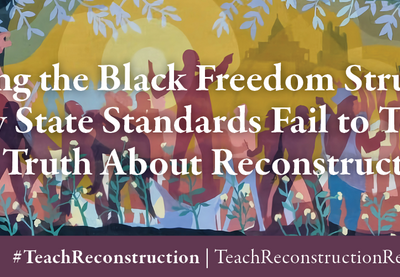Editor’s note: This is a revised, abridged version of an article originally published by Rethinking Schools.
The Radical Promise of Reconstruction
Reconstruction was the era in which 4 million newly emancipated people seized their freedom (to borrow from the evocative title of Dr. Kidada Williams’ fantastic podcast, Seizing Freedom). In thousands of acts of creation, both individual and collective, humble and grand, formerly enslaved people and their allies sought to build the world anew. In the words of Frederick Douglass, the era offered “nothing less than a radical revolution.”
Reconstruction has much to teach us about why our society looks the way it does today—and how it might be positively transformed. However, in the first-ever comprehensive review of state standards on Reconstruction, the Zinn Education Project found that most states do a dreadful job defining the era or outlining for educators its crucial themes. Standards mostly erase the role of Black people striving to execute their vision of freedom, instead favoring a top-down emphasis on government and the role of white people. Black people are included in state standards, but more often as objects than subjects. Even more troubling, many of the standards echo the racist and discredited “Dunning School,” which saw Reconstruction as an era of Black misrule, orchestrated by “scalawags” and “carpetbaggers.”
More than a dozen states direct students to consider whether Reconstruction was a “failure” or a “success,” but neglect to emphasize the role played by white supremacy—in both the North and South—and the efforts of white people to crush the promise of Reconstruction. And state standards mostly fail to link past and present, or suggest how the study of Reconstruction can help young people think more clearly about their world today. Rather than offering students an entry point into a thrilling chapter in the long history of the Black freedom struggle—a struggle that continues—with few exceptions, state standards offer an incoherent, unhelpful tangle of dates and topics.
Check out these Learning for Justice resources on Reconstruction.
The Teaching Hard History podcast episode “Reconstruction 101: Progress and Backlash” features an overview of the era. Historian Kate Masur explains how Black people claimed their citizenship and began building their own institutions—all in the face of post-slavery white supremacy.
“Teaching and Learning About Reconstruction,” an LFJ Moment, offer ways educators can carry the lessons of Reconstruction into their schools and communities and a reminder of why we must be honest with students about the hard history of American slavery.
Reconstruction at School
Zinn Education Project’s Teach Reconstruction campaign seeks to address the dearth of curricular and pedagogical attention to Reconstruction compared to other formative moments in U.S. history (the Civil War or the civil rights movement, for example). The report, Erasing the Black Freedom Struggle: How State Standards Fail to Teach the Truth About Reconstruction, grows out of this campaign. The precise relationship between state standards and teachers’ classroom practice is hard to pin down. But state standards directly influence the content of social studies textbooks, which anchor many teachers’ curricula. The current standards do not make it impossible, but they certainly make it less likely, that educators will teach a robust, accurate, and relevant version of Reconstruction—a version that might serve as a “usable past” for young people today.
That Reconstruction is the subject of significant miseducation is borne out by several states’ standards that reveal traces of the Dunning School, an early 20th century historical interpretation of the era named after the Columbia University historian William Archibald Dunning, whose racist narrative reigned for half a century. In Dunning’s words, Reconstruction was the “scandalous misrule of the carpet baggers and negroes,” a “social and political system in which all the forces that made for civilization were dominated by a mass of barbarous freedmen.”
The most obvious example of Dunning’s lasting influence is the frequency with which the words “carpetbagger” and “scalawag” show up in state standards. Alabama, Oklahoma, and Tennessee standards exhort educators to “explain the role carpetbaggers and scalawags played during Reconstruction.” Standards treat these terms as if they are neutral, and not the political rhetoric of white supremacists intent on reversing gains toward racial equality.
Reconstruction Today
History teachers are fond of talking about history as “relevant” to the modern moment; we want our students to understand that the past offers explanations of our origins, examples to be followed or avoided, models and inspiration for action today. But Reconstruction is more than relevant. It is ongoing. It extends into the modern racial justice movement, which demands that the “badges and incidences of slavery”—which the 13th Amendment enables Congress to destroy—be finally eradicated.
One front in this effort can be seen in the more than two dozen states where rightwing politicians have introduced—and 11 states have enacted—bills or rules to restrict what teachers can say in their classrooms about race, racism, and other “controversial topics.” Teachers across the country—in Missouri, North Carolina, Pennsylvania, Alabama, Arizona—told the Zinn Education Project that they feared these laws would restrict teaching about Reconstruction. A teacher in Iowa explained that the law in his state was having a “chilling effect on current teachers who need to teach about white supremacy and racism in order to do justice to the topic.”
State standards are likely to become another target of the campaign to censor the past. We must be ready to answer those attacks with a commitment to Reconstruction’s importance and the belief that history is not a bargaining chip. Reconstruction was the breathtakingly ambitious effort led by formerly enslaved people to eradicate a brutal and entrenched form of racist exploitation, and to build an entirely new society. In countless ways, that effort continues today. Reconstruction was, to borrow the words of Langston Hughes, the struggle to create “the land that has never been yet.” Reconstruction history—taught well—conveys not just what it was, but what it is, and offers students a role as participants in determining its future.


0 COMMENTS